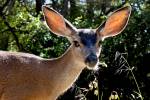First javelina hunt fruitless but educational
From our vantage point on the hilltop west of camp, the landscape all around us seemed devoid of everything but cactus, sundry species of prickly brush and rocks just big enough to roll your ankle. Though the morning still was young, there was no doubt it was going to be unseasonably warm for a New Year’s Day, even in northwestern Arizona.
Suddenly there was a movement in the wash below, a flash of gray where a small, dry stream bed entered a wash that marked the base of the hill. Through my binoculars, I could see two mule deer. One was a three-point buck, but the other deer moved into the brush so quickly that I didn’t get a chance to see what it was. I signaled my partners, Don and Chiz, and they walked over to look down the hill.
In an unexpected twist, the buck’s direction of travel led him directly up the hill to where the three of us stood out in the open. Three or four times along his way the buck seemed to stop and look us over, yet he kept coming. When he finally passed us, the deer presented Don and me with a perfect bow shot at about 10 yards, and at one point we thought he might bump into Chiz. But we weren’t there for deer. We were looking for javelina, something I never had done before.
Though they often are referred to as pigs, and even resemble wild boars, javelina are collared peccary. They range from Argentina in the south to Texas, New Mexico and Arizona in the north. And all three states provide hunting opportunity for these salt-and-pepper colored animals that can weigh 35 to 60 pounds and stand up to 2 feet.
Even though I lived in Tucson, Ariz., for a time as a teenager, I never had seen a javelina in the wild. So my goal for this hunt was twofold. First, I wanted to see a wild javelina; and second, I hoped to put my tag on one. But as the sun began to set on the first day of our hunt, I realized that finding javelina was a challenge. Perhaps more so than I anticipated.
Javelina generally live in small herds averaging eight or nine animals, according to the Arizona Game &Fish Department. Herd territories vary in size but generally are about 750 acres. Though prickly pear cactus is their primary food source, javelina also will eat flowers, nuts, berries, bulbs and the occasional rodent.
The second day of our hunt found us hiking into a basin rimmed with prickly, pear-covered slopes below the dark brown rimrock marking the edge of a large mesa. As with the first day, we kicked up a small herd of deer that included an amorous four-point buck that was so focused on his does that he didn’t seem to care that we were there.
Upon reaching a point that overlooked our destination, we settled in to pick apart the country with our optics. After an hour or so with no luck, I was discouraged. We had seen evidence that javelina were in the area but nothing recent. And we had yet to see one. Then, as Don and I talked at the top of a steep slope, a single javelina suddenly walked into a grassy opening about 30 yards below us and bedded down behind a bush. I waited for the rest of the herd to follow, but the others never showed.
Moving as quietly as possible, Don moved down the slope toward the javelina, a tough task in such rocky country. Suddenly the javelina jumped and ran down the slope and out of bow range. Unfortunately, that javelina proved to be our only opportunity to fill a tag. Despite long days of searching and the miles of country covered, we came home empty-handed.
Though we didn’t fill our tags, I fulfilled half of my twofold goal of seeing a live javelina in the wild. Guess we will have to make another trip next year to reach my goal of tagging one.
Looking back, I might have underestimated javelina. That won’t happen next time.
Freelance writer Doug Nielsen is a conservation educator for the Nevada Department of Wildlife. His “In the Outdoors” column, published Thursday in the Las Vegas Review-Journal, is not affiliated with or endorsed by the NDOW. Any opinions he states in his column are his own. He can be reached at intheoutdoorslv@gmail.com.




















